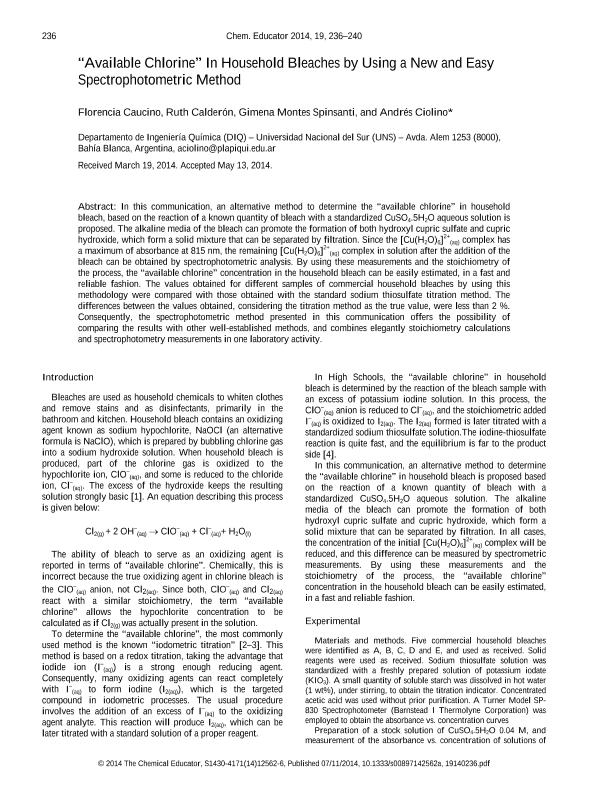Artículo
Available Chlorine in household bleaches by using a new and easy spectrophotometric method
Fecha de publicación:
11/2014
Editorial:
The Chemical Educator
Revista:
The Chemical Educator
e-ISSN:
1430-4171
Idioma:
Inglés
Tipo de recurso:
Artículo publicado
Clasificación temática:
Resumen
In this communication, an alternative method to determine the "available chlorine" in household bleach, based on the reaction of a known quantity of bleach with a standardized CuSO4.5H2O aqueous solution is proposed. The alkaline media of the bleach can promote the formation of both hydroxyl cupric sulfate and cupric hydroxide, which form a solid mixture that can be separated by filtration. Since the [Cu(H2O)6]2+(aq) complex has a maximum of absorbance at 815 nm, the remaining [Cu(H2O)6]2+(aq) complex in solution after the addition of thebleach can be obtained by spectrophotometric analysis. By using these measurements and the stoichiometry of the process, the "available chlorine" concentration in the household bleach can be easily estimated, in a fast and reliable fashion. The values obtained for different samples of commercial household bleaches by using this methodology were compared with those obtained with the standard sodium thiosulfate titration method. The differences between the values obtained, considering the titration method as the true value, were less than 2 %. Consequently, the spectrophotometric method presented in this communication offers the possibility of comparing the results with other well-established methods, and combines elegantly stoichiometry calculations and spectrophotometry measurements in one laboratory activity.
Archivos asociados
Licencia
Identificadores
Colecciones
Articulos(PLAPIQUI)
Articulos de PLANTA PILOTO DE INGENIERIA QUIMICA (I)
Articulos de PLANTA PILOTO DE INGENIERIA QUIMICA (I)
Citación
Caucino, Florencia ; Calderón, Ruth ; Montes Spinsanti, Gimena ; Ciolino, Andrés Eduardo; Available Chlorine in household bleaches by using a new and easy spectrophotometric method; The Chemical Educator; The Chemical Educator; 19; 11-2014; 236-240
Compartir




